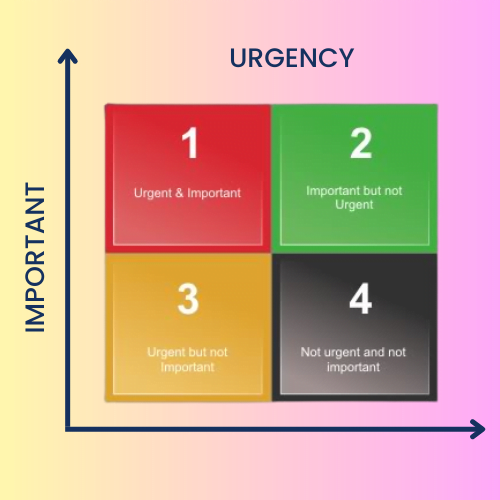Introduction
7 Priortisation Strategies When All Tasks are Important and Urgent: At Improve13, we understand the challenges that come with managing multiple important and urgent tasks simultaneously. In today’s fast-paced business environment, effective planning and prioritization are crucial for maintaining productivity and achieving success. In this article, we will provide you with a comprehensive guide on how to plan and prioritize work when all tasks are important and urgent, enabling you to stay ahead and outperform the competition.
Assessing Task Importance and Urgency
To effectively plan and prioritize work, it’s essential to have a clear understanding of the importance and urgency of each task. Here’s how you can assess them:
Importance
Identify the tasks that align directly with your business goals and objectives.
Consider the potential impact of each task on your company’s success and bottom line.
Evaluate the tasks that contribute to long-term growth and sustainability.
Urgency
Determine the tasks that have immediate deadlines or time-sensitive deliverables.
Take into account any dependencies or prerequisites for completing each task.
Consider the potential consequences of not addressing urgent tasks promptly.
Creating a Task Priority Matrix
A task priority matrix is a valuable tool for visually organizing and prioritizing your workload. Using the Eisenhower Matrix can help you categorize tasks based on their urgency and importance. Here’s how it works:

Important and Urgent (Quadrant A):
Tasks that are both important and urgent should be your top priority. These are critical tasks that require immediate attention to avoid negative consequences.
Important but Not Urgent (Quadrant B):
Tasks in this category are important for long-term goals but may not have immediate deadlines. Allocate dedicated time for these tasks to prevent them from becoming urgent later.
Not Important but Urgent (Quadrant C):
These tasks may have external pressures or time constraints but don’t contribute significantly to your long-term objectives. Consider delegating or finding alternative solutions for such tasks.
Not Important and Not Urgent (Quadrant D):
Tasks that fall into this quadrant are low-priority and should be minimized or eliminated if possible. Avoid spending excessive time and resources on tasks with little impact.
Effective Work Planning Strategies
Once you have assessed task importance, urgency, and organized them using the priority matrix, follow these strategies to plan your work effectively:
Set Clear Goals and Deadlines
Establish specific, measurable goals for each task and assign realistic deadlines. Clear objectives help maintain focus and provide a sense of accomplishment when achieved.
Break Tasks into Manageable Subtasks
Divide complex tasks into smaller, actionable subtasks. This approach makes it easier to tackle tasks incrementally and track progress more effectively.
Utilize Task Management Tools
Leverage task management tools, such as project management software or online productivity platforms, to streamline workflows, assign tasks, and track their status. These tools enable better collaboration and enhance efficiency.
Prioritize Tasks Daily
Every morning, review your task list and reassess priorities based on any new information or changes. This practice ensures that you remain adaptable and responsive to evolving circumstances.
Avoid Multitasking
While it may seem efficient, multitasking can lead to decreased productivity and lower quality of work. Focus on one task at a time to maintain concentration and produce better results.
Delegate and Outsource
Identify tasks that can be delegated or outsourced to others. Effective delegation frees up your time to focus on critical tasks that require your expertise.
Communicate and Collaborate
Maintain open lines of communication with your team members and stakeholders. Regularly update them on task progress, seek feedback, and collaborate on solving challenges collectively.
Conclusion
In conclusion, planning and prioritizing work when all tasks are important and urgent is a skill that can significantly impact your productivity and success. By assessing task importance and urgency, creating a task priority matrix, and implementing effective work planning strategies, you can stay organized, focused, and ultimately outrank your competitors. Remember, success lies not only in the completion of tasks but in the ability to allocate time and resources wisely, ensuring the most critical work receives the attention it deserves.
Also Read: How to Overcome Monday Blues and Get Productive at Work
Frequently Asked Questions (FAQs)
Q1: How do I determine the importance of a task?
A1: To determine the importance of a task, consider its alignment with your business goals and objectives. Assess the potential impact the task can have on your company’s success and long-term growth.
Q2: How do I assess the urgency of a task?
A2: Assessing the urgency of a task involves considering its deadline or time-sensitive deliverables. Take into account any dependencies or prerequisites for completing the task and evaluate the potential consequences of not addressing it promptly.
Q3: Can all tasks be categorized as important and urgent?
A3: No, not all tasks fall under the category of important and urgent. Some tasks may be important but not urgent, while others may be urgent but not important. It is crucial to categorize tasks accurately to prioritize effectively.
Q4: What should I do with tasks that are not important and not urgent?
A4: Tasks that are not important and not urgent should be minimized or eliminated whenever possible. Avoid spending excessive time and resources on these low-priority tasks.
Q5: Is multitasking an effective approach to handle multiple tasks?
A5: No, multitasking can often lead to decreased productivity and lower quality of work. It is more efficient to focus on one task at a time, giving it your full attention and effort.
Q6: How often should I reassess task priorities?
A6: It is recommended to reassess task priorities daily, preferably in the morning. This allows you to adapt to new information, changes, and emerging priorities, ensuring your work remains aligned with current needs.
Q7: What are the benefits of utilizing task management tools?
A7: Task management tools offer several benefits, including streamlined workflows, efficient task assignment and tracking, improved collaboration among team members, and enhanced productivity and organization.
Q8: How can delegation help in managing important and urgent tasks?
A8: Delegation allows you to assign tasks to others, freeing up your time to focus on critical tasks that require your expertise. It can help distribute workload and increase overall efficiency.
Q9: Why is effective communication important in work planning?
A9: Effective communication is vital in work planning as it ensures everyone involved is on the same page. Regular communication and collaboration facilitate transparency, provide updates on task progress, and enable the resolution of challenges as a team.
Q10: How can effective work planning help outrank competitors?
A10: Effective work planning allows you to allocate your time and resources wisely, ensuring that the most critical tasks receive the attention they deserve. By staying organized, focused, and prioritizing strategically, you can increase productivity, produce high-quality work, and gain a competitive edge in your industry.



